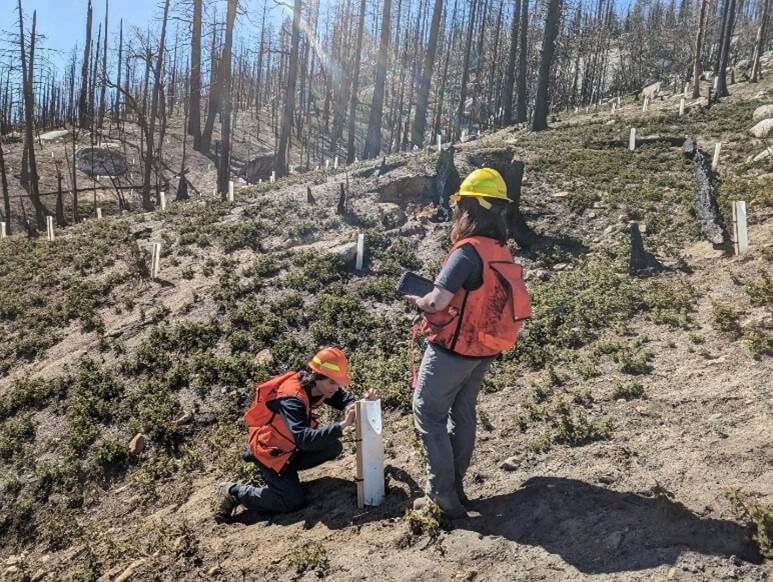Jamie Hinrichs
Pacific Southwest Region
June 8, 2023
It takes a village — of partners and actions — to steward landscapes with giant sequoias (Sequoiadendron giganteum). These towering trees grow naturally only in a narrow 60-mile band on the western slopes of the Sierra Nevada mountains in California. Although they have evolved to be wildfire-resistant, they have been perishing from today’s high-severity wildfires.
All but five of the 36 groves on National Forest System land have burned at uncharacteristically high intensity in recent fires. This led to the USDA Forest Service’s emergency action to reduce hazardous fuel in giant sequoia groves within the Sierra and Sequoia national forests. And for a few of the groves that previously burned at high severity, a reforestation effort took root this spring.
As part of a multi-year, cross-boundary project to improve forest health through reforestation, the national nonprofit American Forests worked closely with Sequoia National Forest personnel to plant over 286,000 trees across 1,380 acres. This included over 14,000 giant sequoia seedlings. The high-severity burn areas within the Converse Basin, Freeman Creek, and Starvation Creek were deforested by the 2015 Rough, 2020 Castle, and 2021 Windy wildfires.
“We were able to accomplish a tremendous amount of work in just 21 days – early mornings and long days in the field always felt like they were worth it, knowing that we are making a difference,” said Kat Barton, Southern California Reforestation Manager with American Forests. “Our hope is that future generations will be able to enjoy forests in the same way we have had the privilege and that these trees will provide habitat, improve watershed health, and sequester carbon to help fight climate change.”
New trees may regenerate on their own after a wildfire if a seed source is nearby. But this often does not occur after high-severity burns when all the overstory trees are dead. In such cases, few, if any, green trees remain. Burned seeds on the forest floor are often unable to develop after experiencing such high temperatures. This is when planting becomes necessary to retain a forest landscape.
American Forests and the Sequoia National Forest worked with contractors to plant locally sourced, native tree species – including giant sequoias – to help the groves recover. Additionally, biochar and shade shelters were placed in the hottest and driest sites. The effectiveness of these tools will be monitored as a part of a climate-smart reforestation pilot study.
Careful choreography of additional actions support reforestation. In high-severity burn areas, debris and fallen trees need to be cleared from the forest floor to allow seedlings to grow in bare mineral soil. Additionally, clumps of burned trees that remain standing need to be removed from some areas. They are structurally weak and may fall soon, endangering the next generation of trees or the tree planters.
But it is equally important to not wait too long to plant. If the landscape remains deforested, brush species that thrive in disturbed areas, like bear clover (Chamaebatia foliolosa), will quickly carpet the forest, absorbing the moisture and space seedlings need to thrive. Many land managers worry about vegetation type conversion, which follows high-severity fire and occurs when forested lands transition to shrublands. This can cause an ecosystem shift and is associated with a loss in biodiversity.
This reforestation effort on the Sequoia National Forest overcame additional complications. The winter’s atmospheric storms left many areas with washed out roads and lingering deep snow. But the seedlings were successfully planted while soil moisture and temperatures were ideal for survival. Another 1,150 acres or more will be planted next spring as part of this partnership.
“Restoration of the landscape on the Sequoia National Forest is happening because of the great working relationship and increased capacity we have as we work with partners.” Gretchen Fitzgerald, Ecosystem staff from the Sequoia National Forest, said. “Public land management is best achieved when we can do it together.”
Sequoia Wildfire Reforestation and Recovery Project is part of a statewide program that puts billions of Cap-and-Trade dollars to work reducing GHG emissions, strengthening the economy, and improving public health and the environment– particularly in disadvantaged communities. The Cap-and-Trade program also creates a financial incentive for industries to invest in clean technologies and develop innovative ways to reduce pollution. California Climate Investments projects include affordable housing, renewable energy, public transportation, zero-emission vehicles, environmental restoration, more sustainable agriculture, recycling, and much more. At least 35 percent of these investments are located within and benefiting residents of disadvantaged communities, low-income communities, and low-income households across California. For more information, visit the California Climate Investments website.
Read the full article on the US Forest Service website.


